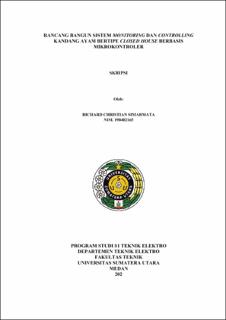Rancang Bangun Sistem Monitoring dan Controlling Kandang Ayam Bertipe Closed House Berbasis Mikrokontroler
Design and Development of a Microcontroller-Based Monitoring and Controlling System for a Closed House-Type Chicken Coop

Date
2025Author
Simarmata, Richard Christian
Advisor(s)
Batubara, Fakhruddin Rizal
Metadata
Show full item recordAbstract
Broiler chickens are one of Indonesia's largest agricultural commodities, with an
annual production of 3.34 million chickens. In the maintenance of broiler chickens, there
is a system known as the closed-housed system. This system utilizes automation to maintain
the temperature and humidity inside the cage according to the age of the chickens. If the
temperature and humidity are not maintained appropriately for the chickens' age, it can
cause stress, thereby disrupting their productivity. Additionally, the existing closed-house
systems do not yet use sensors to detect ammonia. If ammonia levels inside the cage are
not controlled, it can cause respiratory issues in the chickens, potentially leading to their
death. There is a need for a system that can monitor and control the temperature, humidity,
and ammonia levels within the cage. To optimize the system's functionality, Internet of
Things (IoT) technology can be applied, making it easier for users to supervise and control
closed-house type chicken cages. Temperature and humidity measurements are conducted
using the DHT-11 sensor. Ammonia gas levels are measured using the MQ-135 sensor.
The timer used to turn the cage lights and heater on and off according to the chicken
maintenance program utilizes the RTC DS3231. The microcontroller used to process and
regulate the system's operation is the ESP32. For system operations, internet connectivity
is employed along with two internet protocols: WebSocket and HTTP. The system
successfully operates actuators manually through a webpage with a 1-second response
time. The turning on and off of fans, heater, and cage lights was also successfully carried
out automatically according to the chicken maintenance program. The system was also
successful in controlling and detecting ammonia gas levels inside the cage. Data collected
during cage monitoring and supervision were successfully stored in a database. For
temperature and humidity measurements, there was a temperature difference of 0.5°C–2°C
and a humidity difference of 1%–12% between the sensors used in the system and the
anemometer used in the closed-house cage.
Collections
- Undergraduate Theses [1534]
